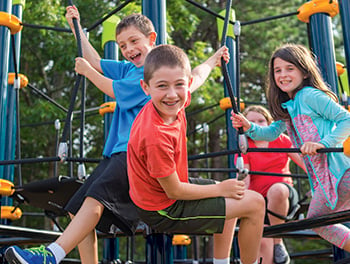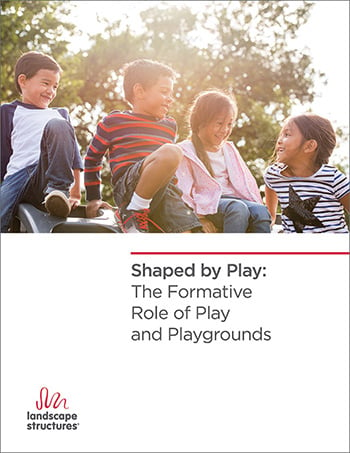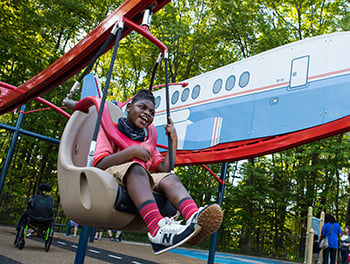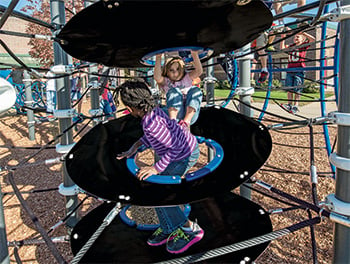Developmental Play & Its Benefits

 When we watch a child play, we aren't necessarily thinking about the cognitive skills they are building or the social impact it will have on relationships later in life, but that is exactly what is happening. Play may look like "just fun" but it is promoting developmental benefits that will eventually help children become effective thinkers, leaders and collaborators. Play is an essential part of a child's development and critical for the successful growth of both the brain and the body.
When we watch a child play, we aren't necessarily thinking about the cognitive skills they are building or the social impact it will have on relationships later in life, but that is exactly what is happening. Play may look like "just fun" but it is promoting developmental benefits that will eventually help children become effective thinkers, leaders and collaborators. Play is an essential part of a child's development and critical for the successful growth of both the brain and the body.
The evidence for associations between play and its positive outcomes is so strong that the National Association for the Education of Young Children (NAEYC) considers it an important component of developmentally appropriate teaching practice, the American Academy of Pediatrics have issued guidelines to help pediatricians, encourage play, and the UN High Commission on Human Rights declared play a fundamental right of all children.
Playgrounds are a key factor in enabling the different types of play that support a child's cognitive, emotional, physical, and social development. The opportunity for free play on playgrounds is different from the structure of physical education classes or organized sports. The free developmental play that intuitively happens on a playground allows children to choose how they play and explore according to their natural tendencies.
Five Skills that Benefit from Multisensory Play
 Playgrounds are essential to providing the context and opportunity for children to play and practice key developmental skills. In our whitepaper, Shaped by Play: The Formative Role of Play and Playgrounds, the University of Minnesota Institute of Child Development examines the link between play and brain—development, motor-skills, and social capabilities. What's been discovered is that emotional, social, motor and cognitive learning is enhanced and accelerated by developmental play.
Playgrounds are essential to providing the context and opportunity for children to play and practice key developmental skills. In our whitepaper, Shaped by Play: The Formative Role of Play and Playgrounds, the University of Minnesota Institute of Child Development examines the link between play and brain—development, motor-skills, and social capabilities. What's been discovered is that emotional, social, motor and cognitive learning is enhanced and accelerated by developmental play.
Playgrounds provide multisensory play experiences and various motor-skill and physical challenges that help to build the brain more quickly. There are also more opportunities on a playground to integrate physical activity with other forms of imaginative play. On playgrounds, children have the space and freedom to run around wildly while playing monsters and aliens, or clamber around the play equipment while pretending to be monkeys at the zoo. Additionally, children's play on playgrounds facilitates interaction with a diverse group of peers and gives children the opportunity to continually build new relationships.
Inclusive Play Partners, Dr. Lucy Jane Miller of the STAR Center and Ingrid M. Kanics of Kanics Inclusive Design Services, LLC, and their research partners, concluded in a 2017 study that intentionally designed, sensory-rich playgrounds with a wide range of developmentally appropriate and varied sensory experiences can support children to attain mastery, self-esteem and motor skills. Our playground designs focus on five specific areas of skill development – sensory, motor, cognitive, strength, and social/emotional – to provide a variety of developmental options from which kids can choose.
The following chart highlights the specific definitions of each developmental skill area and which playground equipment builds and strengthens that skill.
| SKILL |
HEALTH AND DEVELOPMENTAL BENEFIT |
HOW THE ELEMENT REINFORCES THE SKILL |
TYPES OF PLAYGROUND EQUIPMENT THAT STRENGTHENS THE SKILL |
|---|---|---|---|
|
Sensory |
Visual |
Engages/enhances visual skills |
OmniSpin spinner, Swings, Stairs, Sand and Water Table, Rhapsody Outdoor Music equipment, TopsyTurny® Spinner, Roller Table |
|
Auditory |
Engages/enhances auditory skills |
||
|
Proprioception |
Engages/enhances muscle skills--this is further defined by the motor skill category |
||
|
Tactile |
Engages touch |
||
|
Vestibular |
Engages body movement |
||
|
Vestibular+ |
Additional movement in unexpected ways |
||
| Motor |
Fine Motor |
Engages the hands and fingers |
Tunnels, HealthBeat fitness equipment, Balance beams, Facet Forms, Swings, Smart Play® playstructures, Aeronet® Climbers |
|
Agility |
Challenges the user to change body position in space to succeed |
||
|
Balance |
Challenges the user to stay upright and/or keep from falling off equipment to succeed |
||
|
Cardiovascular |
Causes an obvious increase of heart rate during play |
||
|
Coordination |
Challenges the user to use a combination of muscles to succeed | ||
|
Eye-Hand Coordination |
Challenges the user to use a combination of muscles to succeed |
||
|
Endurance |
Distance and/or long duration of muscle work for a longer than typical time period to succeed | ||
|
Motor Planning |
Challenges the user to move through a series of motor skills to succeed | ||
| Strength |
Upper Body Strength |
Challenges the user to increase arm and shoulder muscle abilities while playing | Monkey bars, climbers, slides, rope climber, overhead ladders, Canyon Collection rock climbers, ZipKrooz |
|
Lower Body Strength |
Challenges the user to increase leg and hip muscle abilities while playing | ||
|
Core Body Strength |
Challenges the user to increase trunk muscle abilities while playing | ||
| Cognitive |
Language and Literacy |
Encourages early childhood language and brain development | Nook, Climbing wall, Too Small to Fail enclosures, Sensory Play Center®, Evos® and Weevos® playsystems |
|
Problem Solving |
Encourages user to find solutions to successfully engage in play | ||
|
Strategic Thinking/ Planning |
Encourages users to develop plans to successfully engage in play | ||
| Social/ Emotional |
Social Skill Development |
Encourages users to use verbal and non-verbal methods of sharing thoughts and ideas during play | Cozy Dome, rope climbers, store-front type panels, tunnels, Club House , We-saw™, Sway Fun® Glider |
|
Imaginative Play |
Encourages users to invent scenarios from their imagination that enable them to build life skills | ||
|
Cooperation |
Encourages users to work together to succeed in a play activity |
Learn more about the developmental skills of products, contact your local Landscape Structures playground consultant or download our whitepaper “Shaped by Play: The Formative Role of Play and Playgrounds.”
Playgrounds Designs that Promote Healthy Development
 Playgrounds have a lasting positive impact on a child’s developing brain and body, plus they are fun! By providing different opportunities for kids of all abilities to engage in age-appropriate developmental play, your playground can support the health and development of the whole child—their physical health, as well as the social and cognitive skills that are so important for successful functioning as they grow into adults.
Playgrounds have a lasting positive impact on a child’s developing brain and body, plus they are fun! By providing different opportunities for kids of all abilities to engage in age-appropriate developmental play, your playground can support the health and development of the whole child—their physical health, as well as the social and cognitive skills that are so important for successful functioning as they grow into adults.
Various studies highlighted in our whitepaper show children spend around 80 percent of their time on playgrounds engaging in social, physical and pretend play. Studies further show that types of play can be reinforced by certain playground features, including:
- Climbers, play elements with motion and other varied equipment engage children of all ages and abilities in different ways. Older kids can explore new techniques to reach the top and younger children may find a challenge just standing and holding on.
- Partly-enclosed spaces like crawl tunnels and our Cozy Dome provide an opportunity for children to take a break from play to self-regulate emotions and rejoin play when ready.
- Open-ended play like rope climbers and store-front type panels encourage imaginative and creative play.
Well-designed playgrounds offer something for children of all needs and levels of ability. Check out our many options of playground equipment for children of all ages and get started planning your new playground.
At a Glance: Playgrounds and Development
It might look like play, but while kids explore playgrounds they are building skills that are critical to healthy development.
Cognitive benefits of play
When kids interact and explore on playgrounds, they get the opportunity to problem-solve, think critically and plan strategically. They also practice new language and literacy skills through imaginative play.
Physical benefits of play
 Climbing, jumping and running leads to increased cardiovascular health and increased upper- and lower-body strength. Playgrounds also help improve balance, agility and hand/eye coordination.
Climbing, jumping and running leads to increased cardiovascular health and increased upper- and lower-body strength. Playgrounds also help improve balance, agility and hand/eye coordination.
Social and emotional benefits of play
Playgrounds offer opportunities for kids to collaborate and engage with each other to overcome a challenge.
Sensory benefits of play
Using more than one sense – sight, hearing, touch –is a type of developmental play that helps build a child’s developing brain more quickly.